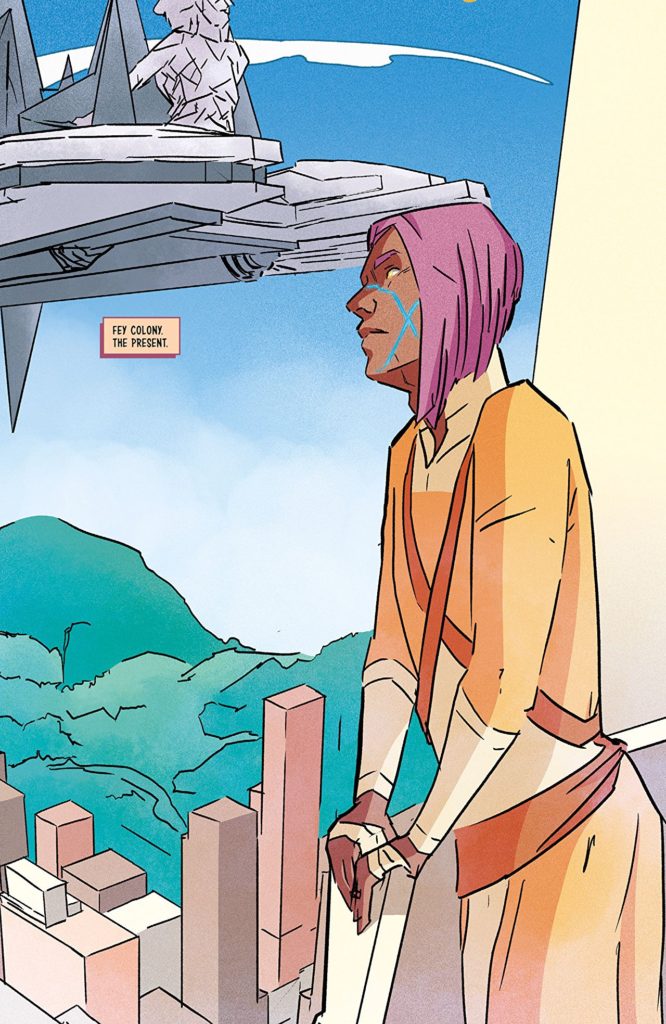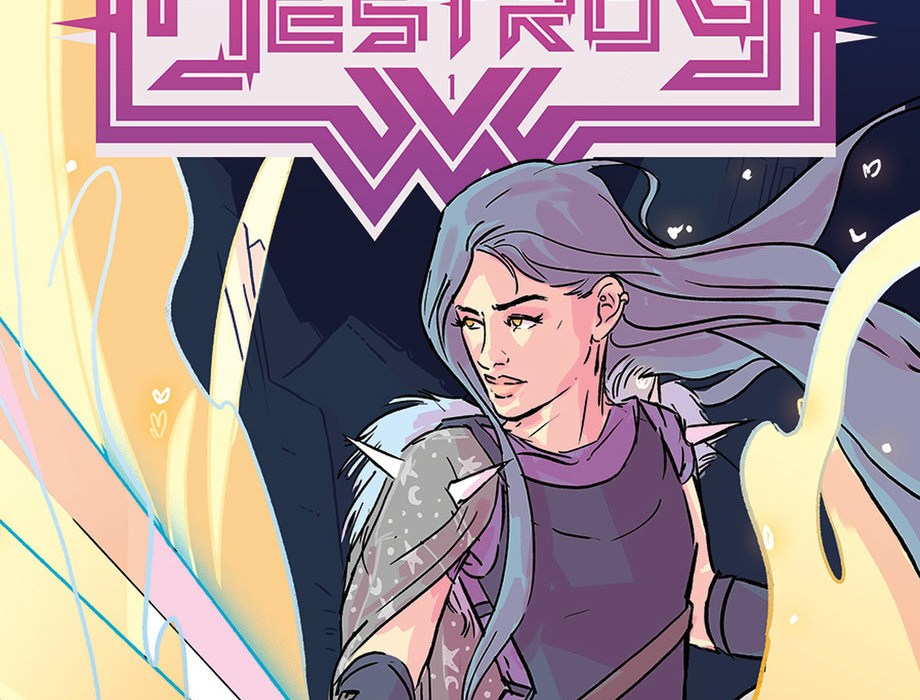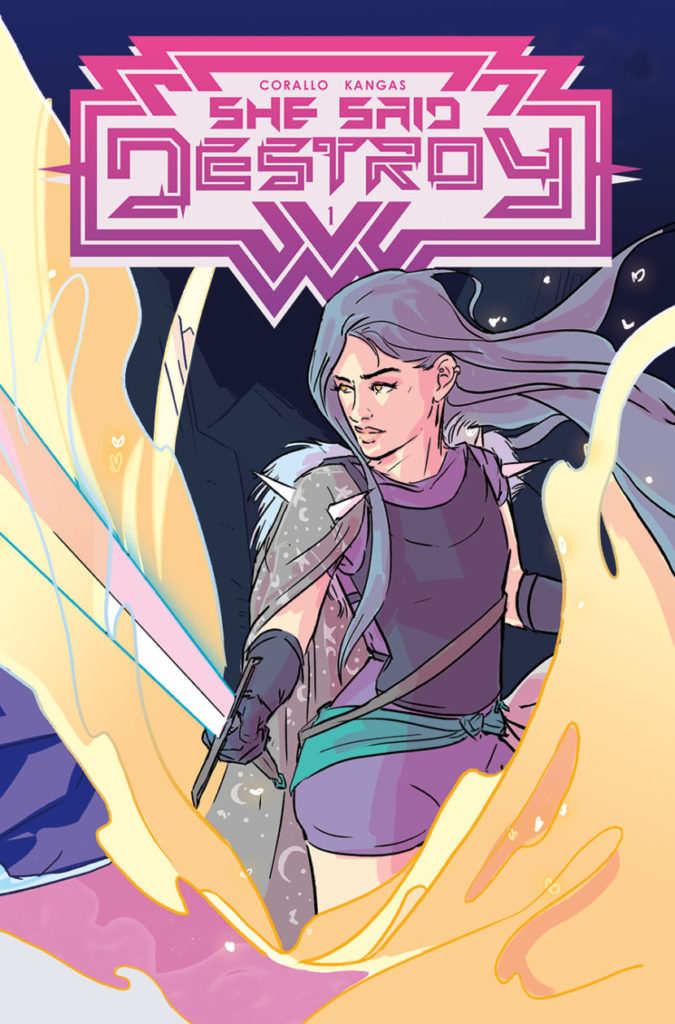It was a quintessential afternoon in the northwest when I sat down to digitally thumb my way through the pages (are they still pages if they’re made of ones and zeros?) of writer Joe Corallo and artist Liana Kangas’ interplanetary epic She Said Destroy. For a few short, gray, wet, and cold hours the world would be bathed in the blue celestial glow of my laptop screen, my imagination suspended in the expanse of a world made all the more real by the fashion on display in each panel.
She Said Destroy, which comes to its epic conclusion with the release of issue five on October 3rd, does not bombard the reader with matters of style. It uses style to steep its characters’ personalities into the readers’ subconscious allowing them to inhabit their skin.
Mother Brigid and The Morrigan
Mother Brigid and The Morrigan are gods, creatures of the divine, finding more in common with the ephemeral power that comes with that rather than the devotees whose worship they survive off of. Shaped by Kangas’ initial character design and final art, their truest selves are revealed despite their desire to distance their followers from their own base human desires that lie just beyond their divine light.
We, the readers, are introduced to The Morrigan and Mother Brigid at an arm’s length. They are the beating heart of the universe and their clothes reflect their holiness and power. The Morrigan achieves this by styling herself as a warrior. From the spikes that sprout from her shoulders to the practical and tactical design of her boots, she distinguishes herself as one whose path is not be crossed lightly—you might just end up on the other side.
The armor she has chosen for herself hints at the divine balance of feminine and masculine energies within her, evocative of Jean Paul Gaultier’s Couture Fall/Winter 2009 show. Romantic moons and stars twinkle across her sheer, midnight black cloak while intimidating crows feathers reminiscent of her transformation into her avian familiar hug her hips.
Mother Brigid positions herself as the hero of the universe locked in seemingly endless war with the death god The Morrigan. Where The Morrigan shrouds herself in night, Brigid personifies the sun’s life-giving rays, her very hair radiating from her head in a crown of fiery curls. The elegant draping of her dress captures the welcoming embrace of a wide-open sky at twilight as its blue hue deepens towards the hem speckled with the first evening stars.
Topped with golden split-hem cowl-neck cape, Brigid exudes regality to rival that of Valentino’s Byzantine-inspired Spring 2016 show. Her look is aspirational, inviting, and imparts a sense of maternal warmth to her followers that has secured her presence—and power—throughout the cosmos.
Who They Were vs. Who They Are
To understand who they have become as the pages of issue five unfold, we must understand who they were. As gods, the attire they adorn themselves with are monuments to their power, the fruits of offerings from the faithful. Their clothing acts as much as a reflection of that power as it does reveal how their paths diverge. A window to the past is flung open allowing the reader to see The Morrigan and Mother Brigid as they were before their intergalactic war began. Kangas uses this moment to highlight where their paths diverge at the dawn of the Christian era.
The Morrigan and Mother Brigid must choose–hold on to their traditions or shed their pagan past to be raised on high by the Christian wave that has felled their kin. For Brigid, the choice is simple and one she goes on to make again and again. She casts aside who she was and, in this instance, dons the Romanesque garb of the Christians who come to love her and make her their own. The beginnings of her galactic god ensemble are alluded to by Kangas who designs a sky blue toga and golden stola for Brigid to adopt. The Morrigan chooses to stay the course. Nowhere is this better exemplified than in her humble tunic and glove ensemble–which she continues to wear–that bears resemblance to those worn by peasants.
Winona and Vrixton
For their followers, Winona and Vrixton, Kangas models their pious attire after those whose celestial light they seek to possess–or distance themselves from. The chasm that separates Winona and Vrixton as devotees of battling gods is punctuated by hierarchical nuances that not only distance them their gods but from the other followers.
Taking notes from The Morrigan, Kangas dresses Winona in a hooded wrap jacket, straight-leg pants, and tactical boot combo that make it clear they are one of many despite their prophesied position as a vessel for The Morrigan. Their humble garb only goes to further point out Winona’s reluctance to accept her fate as those in charge of the Fey insist upon her exceptionalism. She’s just like everyone else. Can’t the Fey see that?
Vrixton, on the other hand, showcases a look that yearns to possess the divinity of Mother Brigid. His geometric-detailed robe is dyed in the same golden hue as Brigid’s cape giving him a heavenly glow that stands in stark contrast to the sea of neutral tones worn by Brigid’s military arm, the Light Knights. A contrasting harness around his chest and layered cloth around his waist give him a combative aura as if he were a shield—Mother Brigid’s own and last line of defense. He persists in his climb to become as close to god-like as possible, using his position to convert conquered worlds to the word of Brigid.

Vrixton and Winona’s divine destinies come to a head as their gods wage their final battle. Vrixton’s hesitance at playing host to Brigid is exemplified in Kangas’ design of their combined form. Where one would expect Kangas to go big and create a look that pulls inspiration from both characters, she instead opts for a subtler approach. Vrixton maintains much of his original appearance. Yet, the face that was once so eager to please Brigid, to be Brigid, now cracks under the pressure of the power she has forced upon him.
Kangas contrasts this fraught and transactional relationship by creating a direct visual counterpoint in Winona and The Morrigan’s combined form. Despite her reticence to accept her fate as the vessel of The Morrigan, Winona effortlessly bears the weight of the god’s power.

Kangas uses elements from both characters’ original designs to create a look that speaks volumes about their harmonious relationship. A flourish of fur at the collar of Winona’s tunic, gloves, and blue at the ends of her hair allude to the god within without sacrificing Winona’s agency over themselves.
All of this transformation, all of this searching for a path to salvation, all of this surviving comes to an epic conclusion in issue five as The Morrigan and Mother Brigid’s battle for the cosmos comes to an end. What will become of Vrixton and Winona and the rest of the faithful as the dust settles? What will their fashion say about who they have become? Pick up She Said Destroy issue five on October 3rd to find out!


Comments are closed.